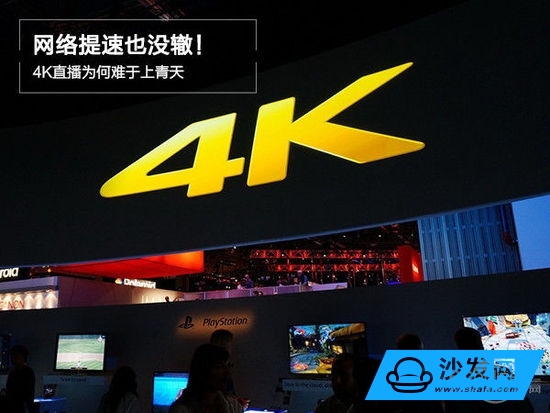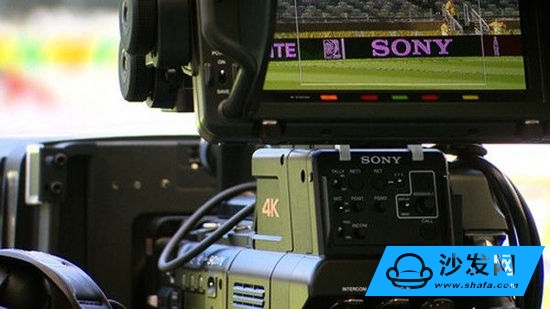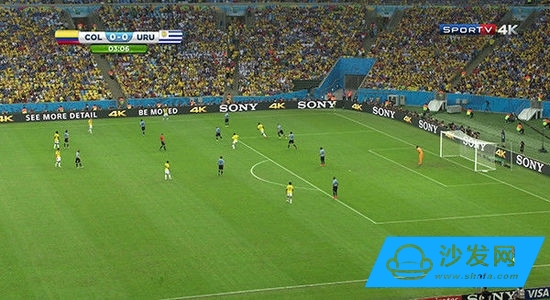After a full year of development in 2015, 4K TV has been basically popularized, and the price of 4K TV is even closer to the people. 2016 is also the Olympic year. Athletes from various countries are busy preparing for the Rio Olympic Games in Rio de Janeiro. As the audience, they expect more of a perfect sports feast. In the 4K TV has been basically popular today, consumers are more likely to enjoy an ultra high-definition live broadcast. However, the official of the recent Brazilian Olympic Games has already stated that this Olympic Games has missed the 4K live broadcast, which is an unfortunate news for many expectants. But what I want to say is that even if the Brazilian Olympic Games support the 4K live broadcast, we are still not on the other side of the ocean.

4K has already appeared, and the cable TV channels that we watch now remain in the SD era. There are very few HD channels, let alone 4K. In contrast, Japan took the lead in opening 4K programs in June 2014. In 2014, with the support of Sony, the Brazilian World Cup opened 4K broadcasts for some of the events. Since then, some countries have also launched 4K programs, and some of the events also support 4K broadcast. In China, it seems that it has not been able to keep up with the rhythm. In fact, 4K live broadcasting may seem easy, but in the face of extremely large domestic consumer groups, it is also difficult to go to the sky.
One of the basic conditions is established - 4K TV
In fact, the realization of the 4K live broadcast is an extremely large project, not to mention China's huge user base. The implementation of the 4K live broadcast requires a whole new set of recording, acquisition, production, and transcoding equipment, which is an astronomical figure in terms of cost compared to existing facilities. Judging from the current situation, there is one thing we already have - 4K TV.

4K TV has been basically universal In almost a whole year of 2015, 4K TV has been widely popularized, and the price of 4K TV is enough to be close to the people. With the advent of Internet TV, more 4K audio and video resources have emerged, and 4K is no longer superfluous. Now, it is still missing 4K live broadcasts.
We are missing a Sony Dafa!
Japan was the first to open a 4K live broadcast. Presumably this is not related to Sony. Sony is almost monopolized in the technology of shooting and live broadcasting in 4K. Sony is undoubtedly the best choice both in terms of equipment and technical support. NHK in Japan has already started broadcasting in the experimental 8K event. How many people have seen the 4K live broadcast in Japan? Please allow the author to shout: Sony Dafa is good.

In fact, 4K live broadcast, domestic is not without, take the recent example. At 19:30 on December 31, 2015, Guangdong IPTV jointly launched by Guangdong Broadcasting and Television, CCTV CNV and Guangdong Telecom of China Telecom Co., Ltd. provided for the first time telecom TV users a 4K live broadcast of Jiangsu Satellite TV. Through Guangdong Telecom's optical network and video fusion CDN, it provides users with a 3.5-hour Ultra HD 4K live broadcast service. In addition, LeTV has won the 2016-2017 season for the next three seasons in Hong Kong Premier League broadcast rights, also announced that it will be part of the Premier League 4K global broadcast.
We always have to slow down a few beats, because we are missing a Sony Dafa!
Broadband is flawed and there is no speed increase!
Even with 4K live streaming, there is a more difficult problem to overcome - broadband. In the 2014 World Cup in Brazil, when the BBC made a 4K live broadcast, 60 frames per second required 36 Mbps of bandwidth, which is what we often call 36M broadband. The report on China's broadband speed in the fourth quarter of 2015 showed that the download rate of China's fixed broadband network reached 8.34 Mbit/s. This is also the first time China's broadband download rate exceeded 8 Mbit/s. Oh, 36M? The popularity of 4K live broadcasting is still out of reach.

In 2015, China’s big-line policy of “speeding up fees and reducing feesâ€, when the author stayed in Guangzhou, he heard that the policy was completed ahead of schedule. I laughed. I did not expect to return home during the New Year, but found it really - my home broadband from 4M small water pipes into 20M fiber. However, this is far from the poor viewing demand of the 4K live broadcast. It seems that we must continue to increase the speed slightly!
4K live broadcasting is still a distant dream Although, 4K live broadcast has been fully realized, but how many people in China, how many people really experienced it? In terms of network speed, the average broadband download rate has just exceeded 8 Mbit/s, and subscribers that meet such broadband requirements still belong to a niche. Not to mention the completion of 4K live broadcasts, not just broadband issues.

As mentioned before, if you want to achieve 4K live broadcasting, you need to replace almost a whole set of recording, acquisition, production, and transcoding equipment. This cost is also much higher than that of ordinary live broadcasting equipment. And even with the support of the equipment, it only solves the problems of collection and recording. For 4K resources, the difficulty of later processing is also increased a lot. Production and transcoding need to face four times the amount of information in full HD, but also to perform more precise editing, rendering, color mixing, lyrics, transcoding and a series of operations, and ensure the output without delay . These work more than normal Full HD video processing.

Finally, in the key transmission part, there is a big difference. The storage space and transmission requirements for 4K resources are many times higher. In the 2014 World Cup in Brazil, when the BBC made 4K live video at 60 frames per second, it required 36Mbps of bandwidth, which is what we often call 36M broadband. Even after today's broadband acceleration, how many people can meet this demand? Even if the new encoding can effectively reduce half of the storage space and only half the bandwidth, it is still higher than most people's home network environment. In addition, the increase in bandwidth is actually not difficult, but the home network is used to transmit 4K live broadcasts, but there is also a lot of pressure. Therefore, the most ideal way is a dedicated line transmission channel, that is to say, need to re-apply for 4K private line business. In this way, consumer acceptance is not necessarily high, which is also a difficult point.
Summary: The popularity of 4K live broadcasting, the simplest of which should be the popularity of 4K television and the satisfaction of bandwidth requirements, is the most difficult and has yet to be improved is the cost and technical issues in the production and transcoding transmission. What's more, at present, the definition of 1080P has been able to meet the viewing needs of most people. At this point, 4K live broadcasting does not seem to be in urgent need. Therefore, the popularity of 4K live broadcasting will have a long way to go.

4K has already appeared, and the cable TV channels that we watch now remain in the SD era. There are very few HD channels, let alone 4K. In contrast, Japan took the lead in opening 4K programs in June 2014. In 2014, with the support of Sony, the Brazilian World Cup opened 4K broadcasts for some of the events. Since then, some countries have also launched 4K programs, and some of the events also support 4K broadcast. In China, it seems that it has not been able to keep up with the rhythm. In fact, 4K live broadcasting may seem easy, but in the face of extremely large domestic consumer groups, it is also difficult to go to the sky.
One of the basic conditions is established - 4K TV
In fact, the realization of the 4K live broadcast is an extremely large project, not to mention China's huge user base. The implementation of the 4K live broadcast requires a whole new set of recording, acquisition, production, and transcoding equipment, which is an astronomical figure in terms of cost compared to existing facilities. Judging from the current situation, there is one thing we already have - 4K TV.

4K TV has been basically universal In almost a whole year of 2015, 4K TV has been widely popularized, and the price of 4K TV is enough to be close to the people. With the advent of Internet TV, more 4K audio and video resources have emerged, and 4K is no longer superfluous. Now, it is still missing 4K live broadcasts.
We are missing a Sony Dafa!
Japan was the first to open a 4K live broadcast. Presumably this is not related to Sony. Sony is almost monopolized in the technology of shooting and live broadcasting in 4K. Sony is undoubtedly the best choice both in terms of equipment and technical support. NHK in Japan has already started broadcasting in the experimental 8K event. How many people have seen the 4K live broadcast in Japan? Please allow the author to shout: Sony Dafa is good.

Sony almost monopolizes 4K live streaming technology
In fact, 4K live broadcast, domestic is not without, take the recent example. At 19:30 on December 31, 2015, Guangdong IPTV jointly launched by Guangdong Broadcasting and Television, CCTV CNV and Guangdong Telecom of China Telecom Co., Ltd. provided for the first time telecom TV users a 4K live broadcast of Jiangsu Satellite TV. Through Guangdong Telecom's optical network and video fusion CDN, it provides users with a 3.5-hour Ultra HD 4K live broadcast service. In addition, LeTV has won the 2016-2017 season for the next three seasons in Hong Kong Premier League broadcast rights, also announced that it will be part of the Premier League 4K global broadcast.
We always have to slow down a few beats, because we are missing a Sony Dafa!
Broadband is flawed and there is no speed increase!
Even with 4K live streaming, there is a more difficult problem to overcome - broadband. In the 2014 World Cup in Brazil, when the BBC made a 4K live broadcast, 60 frames per second required 36 Mbps of bandwidth, which is what we often call 36M broadband. The report on China's broadband speed in the fourth quarter of 2015 showed that the download rate of China's fixed broadband network reached 8.34 Mbit/s. This is also the first time China's broadband download rate exceeded 8 Mbit/s. Oh, 36M? The popularity of 4K live broadcasting is still out of reach.
Broadband Speed ​​Increase Still Cannot Meet 4K Live Broadcast Requirements
In 2015, China’s big-line policy of “speeding up fees and reducing feesâ€, when the author stayed in Guangzhou, he heard that the policy was completed ahead of schedule. I laughed. I did not expect to return home during the New Year, but found it really - my home broadband from 4M small water pipes into 20M fiber. However, this is far from the poor viewing demand of the 4K live broadcast. It seems that we must continue to increase the speed slightly!
4K live broadcasting is still a distant dream Although, 4K live broadcast has been fully realized, but how many people in China, how many people really experienced it? In terms of network speed, the average broadband download rate has just exceeded 8 Mbit/s, and subscribers that meet such broadband requirements still belong to a niche. Not to mention the completion of 4K live broadcasts, not just broadband issues.

As mentioned before, if you want to achieve 4K live broadcasting, you need to replace almost a whole set of recording, acquisition, production, and transcoding equipment. This cost is also much higher than that of ordinary live broadcasting equipment. And even with the support of the equipment, it only solves the problems of collection and recording. For 4K resources, the difficulty of later processing is also increased a lot. Production and transcoding need to face four times the amount of information in full HD, but also to perform more precise editing, rendering, color mixing, lyrics, transcoding and a series of operations, and ensure the output without delay . These work more than normal Full HD video processing.

4K live broadcasting still has a long way to go
Finally, in the key transmission part, there is a big difference. The storage space and transmission requirements for 4K resources are many times higher. In the 2014 World Cup in Brazil, when the BBC made 4K live video at 60 frames per second, it required 36Mbps of bandwidth, which is what we often call 36M broadband. Even after today's broadband acceleration, how many people can meet this demand? Even if the new encoding can effectively reduce half of the storage space and only half the bandwidth, it is still higher than most people's home network environment. In addition, the increase in bandwidth is actually not difficult, but the home network is used to transmit 4K live broadcasts, but there is also a lot of pressure. Therefore, the most ideal way is a dedicated line transmission channel, that is to say, need to re-apply for 4K private line business. In this way, consumer acceptance is not necessarily high, which is also a difficult point.
Summary: The popularity of 4K live broadcasting, the simplest of which should be the popularity of 4K television and the satisfaction of bandwidth requirements, is the most difficult and has yet to be improved is the cost and technical issues in the production and transcoding transmission. What's more, at present, the definition of 1080P has been able to meet the viewing needs of most people. At this point, 4K live broadcasting does not seem to be in urgent need. Therefore, the popularity of 4K live broadcasting will have a long way to go.
Applications of High-Frequency Transformers
1. Switch-Mode Power Supplies (SMPS)
High-frequency transformers are integral components in switch-mode power supplies, which are used to convert AC power to DC power in a wide range of electronic devices.
By operating at high frequencies, these transformers enable the use of smaller and lighter magnetic cores, resulting in more compact and efficient power supplies.
2. Inverter Circuits
Inverter circuits, which convert DC power to AC power, often employ high-frequency transformers.
These transformers allow for efficient power conversion at high frequencies, enabling the design of compact and lightweight inverters for applications such as solar power systems, uninterruptible power supplies (UPS), and electric vehicle charging stations.
3. Telecommunications
In telecommunications, high-frequency transformers are used for signal coupling and isolation in various circuit stages.
They ensure efficient signal transmission at high frequencies, maintaining the integrity of the communication link and reducing interference.
4. RF Amplifiers and Transmitters
In radio frequency (RF) electronics, high-frequency transformers are used in amplifiers and transmitters to match impedances and isolate circuits.
They help in maximizing power transfer efficiency and minimizing signal loss, ensuring optimal performance of RF systems.
5. Pulse Transformers
Pulse transformers are a type of high-frequency transformer specifically designed to handle fast-rising and high-voltage pulses.
They find applications in digital circuits, ignition systems, and other areas where precise control of electrical pulses is required.
6. Wireless Charging Systems
Wireless charging systems, such as those used for smartphones and other portable devices, often incorporate high-frequency transformers.
These transformers enable efficient power transfer between the charging pad and the device being charged, eliminating the need for physical connectors.
7. LED Lighting
In LED lighting applications, high-frequency transformers are used to convert the main AC power supply to the DC voltage levels required by LED drivers.
By operating at high frequencies, these transformers contribute to the overall efficiency of LED lighting systems, helping to reduce energy consumption and heat generation.
8. Industrial Automation and Control Systems
In industrial automation and control systems, high-frequency transformers are used in various circuits to handle high-frequency signals and provide electrical isolation.
They ensure reliable and efficient operation of the automation equipment, contributing to increased productivity and reduced downtime.
In summary, high-frequency transformers are essential components in numerous applications where the ability to handle high-frequency signals and the associated benefits of size reduction, weight savings, and improved efficiency are important. Their versatility and performance make them ideal for use in switch-mode power supplies, inverter circuits, telecommunications, RF electronics, pulse transformers, wireless charging systems, LED lighting, and industrial automation and control systems.
High Frequency Transformer,High Voltage High Frequency Transformer,High Requency Transformer Used For Machine,High Power High Frequency Transformer
Guang Er Zhong(Zhaoqing)Electronics Co., Ltd , https://www.poweradapter.com.cn